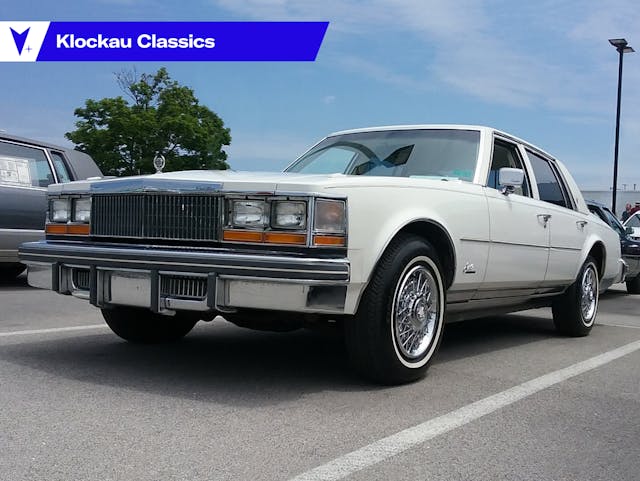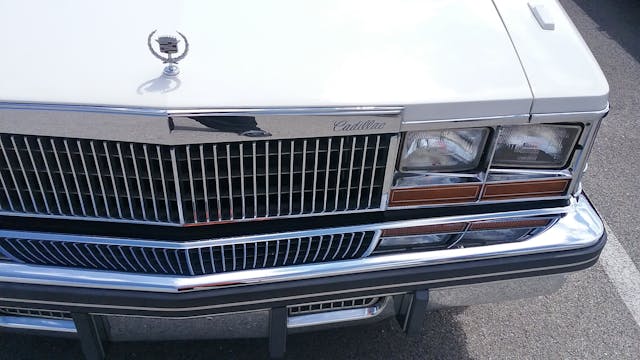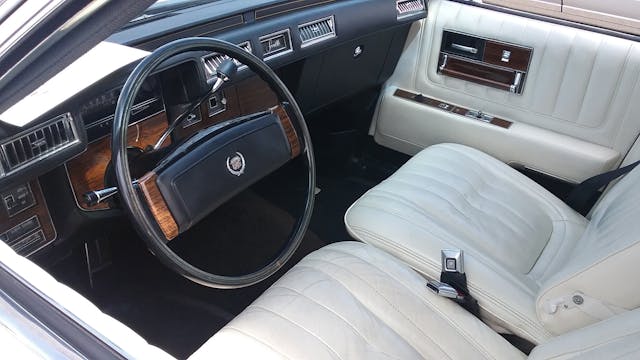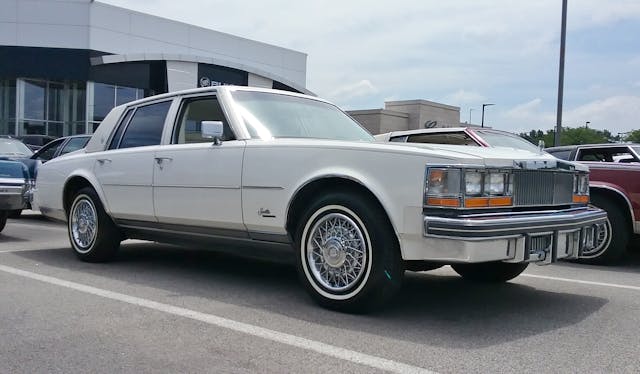1978 Cadillac Seville: Nova? Nope!

Any way you slice it, General Motors made some mistakes in its long history. Good cars, bad cars, government meddling, shrinking vehicles, and corporate incompetence all have a part in what New-ish GM is today. And there are plenty of Monday morning quarterbacks—many with blogs—that gleefully scamper about mocking the less celebratory moments. Sure, mistakes were made; every business has successes and failures. But one thing I disagree with is the theory that the original Cadillac Seville was a giant screwup, or that in any way, shape, or form it was a lightly disguised X-body Nova-based compact. Nope, sorry. Not buying it. But the Internet and social media has at least quadrupled the usual Monday morning quarterbacking, has it not?

Whether you agree or disagree with certain anti-Seville sentiments, some do make a couple of fair points. Yes, the Seville’s start came via the X-body Nova—albeit heavily revised and stretched, to the point of being basically a new car—and the success of the car might well have led the corporate drones to decide on the “tart up an existing platform for obscene profits” M.O. that led to Lexus—oops, I was talking about GM, wasn’t I?—I mean GM’s 2009 downfall. But the original Seville itself wasn’t at fault for later, shall we say, questionable decisions.

A considerable amount of time, effort, and money was spent on the new small Cadillac. Success was critical, and as a result there was none of the bean-counting the company would be charged with in later decades. In the Automobile Quarterly history of Cadillac stated, “The theme of all-out quality and luxury was a topmost priority from the first … Cadillac quickly decided a cheaper Cadillac was simply not the way to go.”

Of course, Mercedes was a significant factor in the Seville’s design, development, and eventual production. The AQ Cadillac book also stated approximately 22,500 Mercedes-Benzes were sold in the U.S. in 1968, and by ’73 it was closer to 44,000. It goes without saying that Cadillacs of that era were Nimitz-class size by anybody’s standard. And because small cars back then almost always made customers think “cheap,” it was also decided that it would be priced above all other Cadillacs—with the exception of the Fleetwood Series Seventy-Five sedan and limousine.

The original Seville (excluding the 1956–60 hardtop version of the Eldorado) was originally going to be called LaSalle, named after the “junior Cadillac” that disappeared after 1940, but after a number of marketing interviews, letters, and surveys, “Seville” was chosen instead. Very early styling drawings and full-size models had a bustle-back prewar Hooper/Daimler style that would be familiar to 1980–85 Seville owners. But the final product was a traditional three-box style with severe sharp corners: Bill Mitchell’s “Sheer” look.

Thus, the Seville came onto the scene in 1975 as an early ’76 model. Introduction was on May 1, 1975. It proved popular, and Cadillac made money on every one. If Cadillac was trying to gain ground on Mercedes-Benz, it succeeded. Once again referring to the Automobile Quarterly Cadillac book: “From May 1975 through April 1976, retail deliveries totaled 44,475 Sevilles (including export and Canada), 45,353 Mercedes-enticingly close figures …” Of course, that included all Mercedes models, and sales back then were heavy on the smaller diesel models, such as the 240D. Still, it was pretty impressive for an all-new model.

Even California, typically thought of as import country, with Mercedes-Benz and BMWs aplenty, saw a lot of Seville interest. At the time there were reports at California Cadillac dealerships of Mercedes-Benzes being traded in on new Sevilles. The 1976 Seville was noticeably smaller than the de Villes and Fleetwoods it shared a showroom with. Overall length was 204 inches, wheelbase was 114.3 inches, and its Olds-sourced, Bendix fuel-injected V-8 produced 180 horsepower and 275 lb-ft of torque. Top speed was 115 mph.

My favorite is the original 1976 model, with its slim checkerboard grille and optional turbine-vaned wheel discs. But the very next model year, the grille was replaced by a more formal one, which had a taller header panel with Cadillac script on the driver’s side and slim vertical bars. It was somewhat similar in style to the many aftermarket Rolls-Royce style grilles that were popping up on not only Sevilles, but big Cadillacs, Lincolns, New Yorkers, and even Ford LTDs. The ’77s also gained the option of a “slick top,” omitting the padded vinyl roof that was the only option in 1976.

Cadillac may have been trying to keep some of the more hideous aftermarket rickrack off of their “international-style” sedan with the more formal grille, but there’s no accounting for bad taste sometimes. Let us not discuss the super-short wheelbase, two-door “Opera Coupe” Seville customs, complete with front fender side-mount spare tires, resembling unlanced boils more than any 1930s classic car. But I digress.

In 1978, the year of our featured triple Cotillion White Seville, the interior seating sew style had a new design for cars ordered with Sierra Grain leather. Ten interior colors were available. Sevilles with standard Dover cloth retained the 1976–77 style narrow vertical pleating. Production was 56,985, up from 1977’s 45,060 units. Base price was $14,267. Midway through the model year, a diesel 350-cubic-inch V-8 was added as an option.

Also new was an even more upper-crust Elegante model, with standard two-tone paint (offered in Platinum and Sable Black, Western Saddle Firemist, and Ruidoso Brown only), genuine chrome-plated wire wheels, Elegante script on the sail panel, and a full-width brushed chrome side molding between the paint breaks. Inside was perforated leather and Ultrasuede seating, leather-wrapped steering wheel, 40/40 Dual Comfort front seats with a center console, and other niceties. The Elegante package added $2600 to the Seville’s base price—$3706 if the power glass Astroroof was included.

The 1979 Sevilles had very minor changes. The standard Seville and Elegante continued to be available, and 53,487 examples were sold. An all-new Seville arrived in 1980—Bill Mitchell’s swan-song design now based on the E-body Eldorado. It was, shall we say, polarizing styling. The Olds 350 V-8 was replaced with a standard 350 Diesel engine, though the Cadillac-only 368 V-8 with digital fuel injection was available as a no-charge option. California-bound non-Diesel ’80 Sevilles got the 350 V-8, however.

This gorgeous ’78 was seen at the Ettleson Cadillac show in Hodgkins, Illinois, in June 2018. I’d seen the car before at the now-defunct Shirey Cadillac car show in Oak Lawn, but it was kind of sandwiched in between other show cars. This time the displayed Broughamage was generously spaced, and I took a whole bunch of pictures. I especially loved the “tuxedo” interior, with white seats, door panels, and headliner, along with black dash, steering wheel, and carpeting.

There were many other very nice Cadillacs and Buicks, including a prewar V-16 and a spectacular Dynasty Red ’73 Eldorado convertible, but they’ll have to wait for a future column. Until then, keep calm and Brougham on! And don’t call it a Nova. Think about it. Would such a successful car, purchased by German car owners in many cases, have done so well if that old internet “Nova” chestnut had any basis in reality? I think not.

I love these cars. Every time I see one at a show I get excited and take a ton of pictures, as was the case with today’s car, owned by Paul Casey. I don’t know him, but he’s a friend of several of my Chicagoland Cadillac LaSalle club buddies Jim Smith, Mike Risatti, and Ron Schweitzer. He’s a lucky man with such a sharp Seville!

It seems appropriate to close with one last quote from the Automobile Quarterly Cadillac book (which I highly recommend, by the way!) defending the K-body Seville’s provenance: “As Gordon Horsburgh [Cadillac’s director of marketing at the time] fumed, politely, ‘Some people have said that Seville is a takeoff from the corporate compact body—the Nova type. Well, as I understand it, all we have in common with that body is a floor plan and one door hinge. If you think that is too much commonality, you might want to consider that the all-new Rolls-Royce Camargue, at about $70,000, utilizes a GM Turbo-Hydramatic transmission!'”
Until next time folks, keep calm, Brougham on, and always tip your bartender.



Nice article. Yes, the K-body platform has its roots in the X-body platform but it’s not a Nova. It’s the same way the F-body platform has its roots in the X-body platform as well but nobody would call a Camaro a Nova.